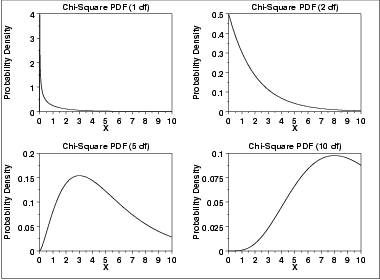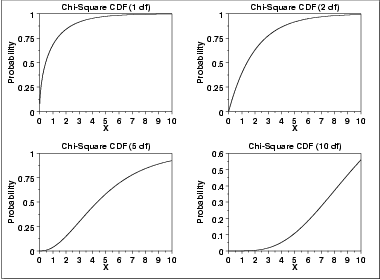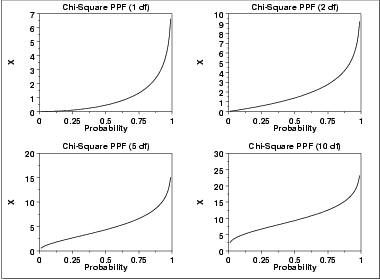| |||||||||||||||||
| Probability Density Function | The chi-square distribution results when  independent variables with standard normal distributions are squared and summed. The formula for the probability density function of the chi-square distribution is independent variables with standard normal distributions are squared and summed. The formula for the probability density function of the chi-square distribution is where  is the shape parameter and is the shape parameter and  is the gamma function. The formula for the gamma function is is the gamma function. The formula for the gamma function is![GAMMA(a) = INTEGRAL[t**(a-1)*EXP(-t)dt] where the
integration is from 0 to infinity](http://www.itl.nist.gov/div898/handbook/eda/section3/eqns/gammfunc.gif) In a testing context, the chi-square distribution is treated as a "standardized distribution" (i.e., no location or scale parameters). However, in a distributional modeling context (as with other probability distributions), the chi-square distribution itself can be transformed with a location parameter,  , and a scale parameter, , and a scale parameter,  . .The following is the plot of the chi-square probability density function for 4 different values of the shape parameter.  | ||||||||||||||||
| Cumulative Distribution Function | The formula for the cumulative distribution function of the chi-square distribution is where  is the gamma function defined above and is the gamma function defined above and  is the incomplete gamma function. The formula for the incomplete gamma function is is the incomplete gamma function. The formula for the incomplete gamma function is![GAMMA(a,x) = INTEGRAL[t**(a-1)*EXP(-t)dt] where the
integration is from 0 to x](http://www.itl.nist.gov/div898/handbook/eda/section3/eqns/igamfunc.gif) The following is the plot of the chi-square cumulative distribution function with the same values of  as the pdf plots above. as the pdf plots above. | ||||||||||||||||
| Percent Point Function | The formula for the percent point function of the chi-square distribution does not exist in a simple closed form. It is computed numerically.The following is the plot of the chi-square percent point function with the same values of  as the pdf plots above. as the pdf plots above. | ||||||||||||||||
| Other Probability Functions | Since the chi-square distribution is typically used to develop hypothesis tests and confidence intervals and rarely for modeling applications, we omit the formulas and plots for the hazard, cumulative hazard, survival, and inverse survival probability functions. | ||||||||||||||||
| Common Statistics |
| ||||||||||||||||
| Parameter Estimation | Since the chi-square distribution is typically used to develop hypothesis tests and confidence intervals and rarely for modeling applications, we omit any discussion of parameter estimation. | ||||||||||||||||
| Comments | The chi-square distribution is used in many cases for the critical regions for hypothesis tests and in determining confidence intervals. Two common examples are the chi-square test for independence in an RxC contingency table and the chi-square test to determine if the standard deviation of a population is equal to a pre-specified value. | ||||||||||||||||
| Software | Most general purpose statistical software programs support at least some of the probability functions for the chi-square distribution. | ||||||||||||||||
Runs Test for Detecting Non-randomness Purpose: Detect Non-Randomness The runs test ( Bradley, 1968 ) can be used to decide if a data set is from a random process. A run is defined as a series of increasing values or a series of decreasing values. The number of increasing, or decreasing, values is the length of the run. In a random data set, the probability that the ( I +1)th value is larger or smaller than the I th value follows a binomial distribution , which forms the basis of the runs test. Typical Analysis and Test Statistics The first step in the runs test is to count the number of runs in the data sequence. There are several ways to define runs in the literature, however, in all cases the formulation must produce a dichotomous sequence of values. For example, a series of 20 coin tosses might produce the f...





Comments
Post a Comment